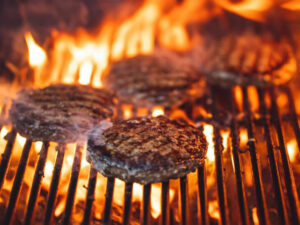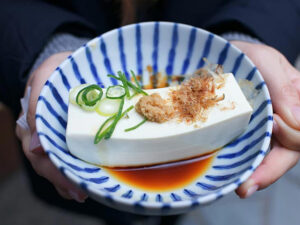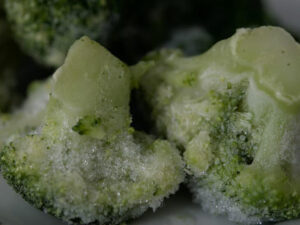OCTOBER 8, 2022

The produce section at a grocery store.
I’ve been a broke college student, a foolish spender, and a broke grad student. I’ve been unemployed multiple times.
Grocery shopping with almost no money and feeding myself while broke were the norm for several long stretches.
If you’re working with a very tight grocery budget, you can find plenty of foods at the supermarket that won’t set you back much at all.
Here’s my list of 68 cheap foods to buy when broke. 67 of them are not ramen noodles!
Vegetables
Being broke doesn’t mean that you can’t make healthy meals or buy healthy foods like fresh vegetables. If you buy vegetables when they’re in season, the prices are much lower. To see what’s in season and when you can use this guide to seasonal produce.
1. Potatoes
In addition to being affordable and nutritious, potatoes can be prepared many ways. They go for less than a dollar a pound. If you opt for a 5-pound bag of Idaho or russet potatoes, you can get them even cheaper.
2. Carrots
Carrots are cheap vegetables that are good to keep on hand. You can eat them raw, cooked, as a filling snack, or as a side dish. Buying full-size carrots in bulk is usually the cheapest option, but sale-priced baby carrots can be a good deal too.
3. Sweet Potatoes
Naturally sweet, very healthy, and inexpensive, sweet potatoes are an excellent alternative to mashed or baked white potatoes. Sweet potato fries have pretty much replaced french fries in our house. We rarely add anything to them as they’re flavorful and sweet enough on their own, but you can add other cheap toppers like sugar, cinnamon, or butter.
4. Canned Tomatoes
The prices for fresh tomatoes vary so much it’s hard to know if you’re paying too much. If you’re making sauce, soup, or stew, canned tomatoes are sometimes a lower-cost option.
5. Squash
A nutritional powerhouse with a mild and nutty flavor, butternut squash is super cheap when it’s in season. It also freezes well if you want to store any excess for the winter.
6. Zucchini
Zucchini is a cheap, tasty, and versatile summer staple. Bake it, stir fry it, eat it raw, or make zoodles. We used to grow these in our garden and swap them with our neighbors for cucumbers, cherry tomatoes, and whatever else they grew in surplus.
7. Peas
We don’t buy a ton of canned veggies, but we always have a can of peas in our cupboards. A wonderful source of protein that’s easy to prepare, you can serve frozen or canned peas on the side of anything. You can also throw a handful into a dish to give it a shot of protein, color, and fiber.
8. Broccoli
Broccoli is usually available at a pretty good price when you buy the whole head. Precut florets can be a good deal when they’re on sale since you’re not paying for the stalk which most people don’t use even though they should.
9. Spinach
Spinach won’t be the cheapest veggie in your shopping cart, but it’s not exactly expensive either. Leafy greens like spinach boost the nutritional value of any meal. Swap spinach for lettuce in salads or on sandwiches. Add a handful to smoothies, omelets, or pasta dishes.
10. Green Peppers
Rich in iron and vitamin C, green peppers make for a low-calorie snack or addition to other dishes. They’re cheap when in season and on sale. While it’s true that red and yellow bell peppers pack more nutrients, they might not be worth the extra dollar on a low budget.
11. Canned Pumpkin
Most people think of Halloween when they see a pumpkin. I think of all the delicious Fall dishes you can make with canned pumpkin that are not pumpkin pie. Soup, bread, ravioli, and all kinds of sweet treats. You can get a can for under a buck.
12. Cabbage
Inexpensive, low in calories, and high in fiber, cabbage is a staple in our house. Besides making slaw, cabbage rolls are a family favorite. We also boil and roast it for a healthy side dish.
13. Cucumbers
Depending on the season and the stores in your area, cucumbers can be incredibly cheap. You can eat them raw on top of salads or with dip, pickle them, or make many tasty sides. Cold cucumber soup on a hot day will cool you right off.
14. Celery
Celery is a good buy year-round. Add it to salads or top it with peanut butter for a tasty snack. Toss it into soup or a stir-fry to add a little crunch. Filling, but not a lot of calories.
15. Lettuce
Most lettuce varieties are affordable and nutritious. Even the cheapest iceberg lettuce is a good source of vitamins A, K, and others. It gets a little boring just using it for sandwiches and salads. We like to cut it into wedges, then throw them on the grill for a nice change.
16. Kale
Kale is often touted as a superfood and a must-have ingredient for green smoothies. While it’s chock full of vitamins, antioxidants, and essential minerals, it’s also not that costly. We can find it around here for less than $1.50 a bunch. Sometimes the 1 and 2-pound bags can be a bargain if you can use it all.
17. Onions
Onions are one of those basic foods that are good to have on hand all the time. They store well and enhance the flavor of almost any dish. They’re also available at a good price most of the year.
18. Garlic
Garlic has many proven health benefits and it’s a powerful flavor addition to any meal. A little goes a long way and garlic has a long shelf life. Buy bulbs, not the peeled or chopped kinds in jars to save the most money.
19. Bagged Salad
Bagged salad mixes are not usually a good deal for what you get. You can make a bigger, cheaper salad with a head of lettuce, a couple of carrots, maybe some purple cabbage, and whatever else you have in the crisper. That said, sometimes bagged salad goes on sale at very tempting prices. A couple of our local markets will do buy one, get one free deals which makes them an inexpensive option.
Fruits

Fresh fruits on display at a supermarket.
Fresh fruit makes for a cheap and healthy snack when you’re on the go or an alternative to unhealthy desserts. If you have an Aldi or other discount grocer near you, the prices are bound to be lower than the big chain supermarkets. Remember to buy in season! Here’s that guide again.
20. Apples
Apples are one of the cheapest fruits and the best deals in the produce department when you buy inexpensive varieties like Gala or Red Delicious. You can find at least one variety in season all year round.
21. Bananas
A bunch of bananas is another great deal you’ll find in the produce section. They’re also my favorite portable nutritious snack. There was a time when I never left for work without one. They’re a good way to get more potassium and fiber into your diet.
22. Oranges
Everyone knows oranges are high in vitamin C and delicious. You can find them year-round, but the prices are not that great off-season. I don’t go to the trouble to make fresh OJ, but it is much better than the stuff from concentrate.
23. Cantaloupe
Not as cheap as other choices, but a good change of pace if you ever get sick of apples, oranges, and bananas. Plenty of vitamins and minerals. Goes great with yogurt or in a fruit salad.
24. Kiwi
In season, we can get kiwi at Aldi and other grocers at 3 for 99 cents. Sweet, juicy, and a superb source of vitamin C, they’re refreshing on their own. They also go well in a fruit salad.
25. Watermelon
I can’t imagine a summer without watermelon. It’s super cheap, keeps you hydrated, and there’s more to it than just its high water content. Watermelon is also a good source of vitamin A, vitamin C, and potassium.
26. Grapes
You don’t have to look hard to find a fantastic deal on grapes during the summer months. Great for snacking on right from the fridge or freezer and a good add-in to that summer fruit salad I keep talking about.
27. Canned Fruit
We almost always go for fresh over canned fruit, but we do buy canned pineapple and mandarin oranges when fresh ones are unavailable. They’re reasonably priced and not ruined by being packed with syrup.
Grains

The cereal aisle at Walmart.
In a gluten-free, low-carb world, many people are cutting down or eliminating grains from their diet. Grains are a staple of many world cuisines and whole grains have unique health benefits, though. If you can tolerate them, you’re not on a restrictive diet, and you’re looking for the cheapest foods to buy on when you have no money, grains are easy on the wallet, versatile, and easy to prepare.
28. Rice
Rice is quick, easy to make with or without a rice cooker, and versatile food. It’s also dirt cheap. You can pick up several pounds of white or brown rice for a few dollars.
Rice is gluten-free unless it’s processed with other products that contain gluten. Brown rice is also high in fiber and contains essential minerals such as magnesium.
29. Bread
Bread is something you’re always going to want to have on hand when you’re struggling to make ends meet. It can be the cornerstone of breakfast and lunch. Forget about the expensive artisan stuff and go for the store-brand loaves. Whole wheat costs a little more, but it’s still cheap.
30. Pasta
I put pasta right up there with ramen on my list of cheap foods to buy when broke. It costs a few cents per serving, it’s filling, and making a tasty, inexpensive meal out of it requires zero skill. So right up my alley. Pasta should be a staple when buying groceries on a tight budget.
31. Cereal
Cereal has a wide range of price points and nutritional value. The breakfast cereal varieties with less sugar and no cartoon mascot are better for you and often cheaper than the sugary kid stuff. It’s quick, easy, and costs pennies per serving. Stick with generics or store brands and save $1-$3 per box.
32. Oats
Oats for breakfast works whether you’re broke or flush, because they’re hearty, naturally gluten-free, and a high-quality source of vitamins, minerals, and fiber. Oatmeal cookies are a cheap treat and simple to whip up with a few additional ingredients.
Prices vary depending on where you shop and whether you buy steel cut, rolled, or instant. Aldi and Costco are where we get the best prices.
33. Cream of Wheat
Slightly more expensive than oatmeal, but not pricey by any means. It has quite a bit of nutritional value, but it’s a bit of an acquired taste for someone like me. I grew up on grits and oatmeal. I’d take either over cream of wheat any day, but cream of wheat with almond milk was my beautiful Sara’s go to breakfast during our vegan days.
Meat

Hamburgers on a grill.
The meat department is probably not the first place you head when you’re looking for cheap foods to buy. There are plenty of meat bargains to be had, however. We get deeper into it in our How to Save Money on Meat post, but here are some meats you can buy when you’re on a tight budget.
34. Chicken
Buying a whole fresh chicken and carving it yourself is cheaper than thighs or drumsticks. Use the bones for stock and the meat on its own for chicken soup, chicken salad sandwiches, chicken pot pie, or in other dishes. If you can’t live without boneless, skinless chicken breasts or chicken wings, frozen is generally cheaper than fresh, sometimes a lot cheaper.
35. Ground Beef or Ground Turkey
There are a ton of cheap tasty meals you can make with ground beef and ground turkey, besides making burgers. We add it to pasta or make tacos, casseroles, and rice bowls. You can probably find a good deal on ground beef or ground turkey somewhere depending on the stores in your area. Stretch out a family pack of ground beef even further by adding a can of black beans, lentils, or your favorite bean to it.
36. Chuck Roast
Chuck roast is cheap, but as with most cheap cuts of beef, it takes some effort to get them tender. Our go-to method is browning it and then throwing it into the slow cooker with veggies, beef broth, and some spices for a nice pot roast. We get a delicious meal along with plenty of leftovers and the entire house smells amazing while it’s going.
37. Pork
The other white meat is pretty inexpensive compared to beef. Pork chops appear on our dinner menu fairly frequently when they’re on sale. Tenderloin we look for during grilling season. Same for pork shoulder, which I do low and slow outdoors.
38. Canned Tuna
Canned tuna is a cheap source of protein and omega-3s. Tuna sandwiches are standard, but you can use tuna in casseroles, pasta dishes, and on top of salads. Stock up when it’s on sale since it doesn’t require refrigeration and has a long shelf life of 3 to 5 years.
39. Hot Dogs
OK, not one of the most nutritious foods on this list, but I’m not suggesting they should be a staple. Hot dogs are an affordable food, they’re easy to prepare, and an odd one here and there won’t ruin your health.
Vegetarian and Plant-Based Proteins

Person holding a prepared tofu dish.
A few years ago, my wife and I challenged ourselves to eat a vegan diet for 30 days. I was concerned about not getting enough protein, but that didn’t happen. You can get plenty of protein from a variety of sources that aren’t animal protein or animal products, including:
40. Chickpeas
Chickpeas are an excellent source of protein and fiber. 1 cup of cooked chickpeas has about 13 grams of fiber. Use them to make your own hummus or add them to salads. Mash them up, add spices, then form patties to make falafel or veggie burgers.
41. Lentils
Lentils are one of the cheapest sources of protein when you buy them dry. Unlike other dry beans, they don’t have to soak overnight and they cook quickly. Lentil soup and lentil chili are easy to make and quite tasty.
42. Tofu
Not the most flavorful stuff on its own, but it’s a cheap protein source that takes on whatever flavor you add to it with sauces or spices. Firmer varieties do well baked and in stir-fries. You can add silken tofu to a smoothie to give it some extra protein. If you have an Asian grocery store near you, you can find blocks for around a dollar.
43. Seitan
Seitan is often referred to as “wheat meat” for its meat-like texture and taste. Seitan is a versatile substitute for beef or chicken, but it’s not suitable if you’re on a gluten-free diet as it’s made from wheat gluten. You can find it in supermarkets next to tofu.
44. Tempeh
Tempeh is made from fermented soybeans. It’s usually sold in blocks near the tofu. It has a bit of an earthy flavor and a firm texture. You can slice it, then marinate and bake it to use in sandwiches or entrees. You can also crumble it for use as a substitute for ground meat in chili or tacos. A 4-ounce serving contains about 21 grams of protein.
45. Edamame
Edamame is the Japanese name for immature soybeans in their pod. They’re usually boiled or steamed and served as an appetizer or snack. You can sometimes find frozen edamame either shelled or unshelled at a reasonable price. We get the best prices at our local Asian market.
46. Chia Seeds
Chia seeds are tiny black seeds that are rich in protein, fiber, potassium, iron, and calcium. When you soak them in liquid, they become gelatinous so you use them as a thickener for smoothies, salad dressings, or soups. We get them at Costco, but you might find them in the bulk bins or health food section at your nearby supermarket.
47. Nutritional Yeast
Nutritional yeast is a vegan-friendly substitute for cheese. It’s usually sold in powder or flakes and it adds a bit of a cheesy flavor, so you can use it just like you would parmesan cheese. Add it to popcorn, pasta, salads, or soups. Not all grocery stores carry it, but you might find it in the bulk bins or health food aisle of your local supermarket.
Frozen Foods

Closeup of frozen broccoli.
Frozen food is easy to prepare and can be stored for a long time. If you can afford it and you have the freezer space, you can stock up when a good deal comes along. Complete frozen dinners are usually not the healthiest foods or a good value plus they often come loaded with sodium which is bad for my blood pressure, so we don’t buy them.
48. Frozen Vegetables
Frozen vegetables are just as nutritious as fresh. We prefer frozen over canned vegetables. They’re a good option when your favorites aren’t in season. We regularly buy frozen mixed vegetables, green beans, and broccoli. You can add frozen veggies to soups and stews or microwave them for a quick lunch or dinner side dish.
49. Frozen Fruits
In winter, the availability of many fruits goes way down and the prices go way up. That’s when we turn to frozen fruit. For some fruits with a short peak season like berries, we buy frozen berries over fresh berries more often than not. You still get all the health benefits, without the high price.
50. Riced Cauliflower
If you’re familiar with keto or low-carb diets, you’re probably familiar with cauliflower rice. I’ve tried to make it myself to serve on the side of our keto dinner recipes with little success. Normally, we don’t buy prepackaged foods, but the homemade attempt came out either too mushy or too much like a raw vegetable. Not a good substitute for the white rice or starchy carbs I sometimes crave while I’m doing keto. My solution was to buy bags of frozen riced cauliflower. It’s cheap and stands in for rice perfectly.
51. Frozen Waffles
Dropping a couple of frozen waffles in the toaster always reminds me of being a kid. I can get a 10-count box of the store brand waffles for $1.25. A fast, simple, and cheap breakfast or a quick snack.
52. Frozen Pizza
When you need a cheap meal and money is an issue, frozen pizza does the trick. You can add fresh or frozen vegetables to up the nutrient content and bulk up the meal. We can get a 12-inch frozen pizza for around $3 on sale. A couple of stores around here do 10 for $10 deals on the individual-size ones.
Dairy

The dairy case at a discount supermarket.
You’ll find plenty of cheap food options in the dairy case. Dairy products provide an easy and inexpensive way to get more calcium, vitamin D, and protein into your diet. We have some tolerance issues in our family so we don’t eat a ton, but we do always have some dairy products in our fridge.
53. Milk
Besides being cheap, milk is a refreshing drink packed with protein and several important nutrients. It’s also a key ingredient in several money-saving recipes. You can make pancake batter, soups, mac and cheese, desserts, and more with milk.
54. Yogurt
Plain yogurt has probiotics, protein, and calcium. Regular has more calcium while the Greek style has more protein. Stir in some cut-up fruit for a quick breakfast or snack. A big tub of store-brand yogurt is usually a good value, as long as you finish it before it goes bad.
55. Cottage Cheese
Cottage cheese is a pretty good value for a filling, high-protein snack. It comes in many flavors, but save your money and buy the plain store brand, then mix in your own fruit or seasonings.
56. Eggs
Our family of five goes through a lot of eggs between breakfast, breakfast for dinner, baking, and egg dishes we love like quiche. They’re an affordable food, they’re nutritious, and eggs have so many uses. If you’re doing keto on a budget, eggs are a staple. Aldi, Costco, and Walmart usually have the best prices on a dozen eggs in our area.
57. Cheese
Obviously, we’re not talking about fancy pants imported cheeses here. If you stick with supermarket staples like American, Mozzarella, or Cheddar and avoid cubed and other convenience packs, you can get cheese for a pretty good price. A grilled cheese sandwich makes for a tasty and filling lunch.
58. Sour Cream
Sour cream is one condiment that won’t go to waste before it expires. You can add it to any soup or sauce to make it thicker. You can also top baked potatoes, tacos, or burritos with it. We buy the store-brand medium-sized tub for less than a dollar.
Pantry Staples

Peanut butter on white bread.
Cheap recipes rely on cheap ingredients, and these pantry items are the things to always have on your list when shopping for frugal foods. Besides being inexpensive, these items have a long shelf life. Keep these in your pantry so that when money is scarce, food won’t be.
59. Dry or Canned Beans
Rice and a can of kidney beans with a little salsa or ground beef mixed in if I was lucky was my go-to dinner. Beans are economical, widely considered good for you, and fill you up. A bag of dried beans is even cheaper, but soaking overnight and cooking them on the stove takes way more time than opening a can and heating them up a bit.
60. Salsa
It’s cheaper to pick up jars of pre-made salsa than it is to make your own or buy the fresh restaurant-style varieties in the refrigerator case. You can toss it with or put it on top of baked potatoes, mix it with rice and beans, or add it to almost anything to provide more flavor.
61. Baking Ingredients
There are tons of cheap foods you can make with flour, baking soda, baking powder, yeast, and things you probably have on hand like sugar, salt, butter, and water. Keep these super cheap ingredients in your cupboard and make homemade bread, pancakes, pasta, tortillas, muffins, cookies, cakes, and more.
62. Ramen
No list of cheap groceries would be complete without ramen. It’s probably the first thing you think of when you think of cheap foods to buy when broke. For a quick meal, just add water and in three minutes your hunger disappears. At $5.76 for a case of 24 at Walmart, it might be the cheapest meal you can find.
63. Mac and Cheese
You won’t mistake boxed mac and cheese for homemade, but it is a decent bargain, even if you need to add milk and butter. You can add veggies or ground meat to it for an easy one-pot meal. If you’re OK with the off-brands, you can pick it up for 35 to 55 cents a box at Walmart, Target, or discount grocery stores.
64. Popcorn
Popcorn is a cheaper and healthier option than chips. When it’s air-popped and lightly seasoned, popcorn can be a healthy whole-grain snack. If you buy jars of popcorn kernels instead of the microwave stuff or the popped and bagged gourmet brands, it’s also extremely cheap.
65. Peanut Butter
Peanut butter lasts a long time, it’s cheap, and kids like it. During my leanest times, a peanut butter sandwich and a banana were my go-to brown bag lunch. We buy large jars of natural peanut butter in 2 packs at Costco.
66. Tea Bags
As much as I love coffee, sometimes I simply couldn’t afford it. I still needed my morning jolt regardless of my grocery budget, so I’d switch to tea. I’m not a tea connoisseur by any stretch, so the cheapo store-brand tea bags in 100-bag boxes worked fine for me. We still buy them year-round for iced tea.
67. Tomato Sauce
When I was broke, I always had jars of tomato sauce in my cabinet. With a box of spaghetti and a jar of sauce, I could eat for a couple of days for under $2. Forget brand loyalty, though. There’s almost always some brand on sale somewhere for $1 a jar or less.
68. Spices
If you’re going to be eating cheap, you don’t have to sacrifice flavor. Hit Aldi or your local dollar store for incredible bargains on dried herbs and spices. I can’t tell the difference between the $1 jar of Italian seasoning at Family Dollar and the name-brand $5 jar at the supermarket.
Broke Grocery List

Everyone’s favorite cheap food to buy when they have no money: ramen noodles.
If you need to control your food spending or you just aren’t able to spend much money on groceries, plan your meals around the cheapest foods that are versatile enough to make multiple frugal meals. To give you some cheap meal ideas, here’s what my typical shopping list looked like when I was broke and struggling:
- Apples
- Bananas
- Celery
- Rice
- Beans
- Oatmeal
- Pasta
- Ramen
- Tea bags
- Tomato sauce
- Bread
- Peanut butter
- Frozen mixed vegetables
- Ground beef
If I was really down to the last few dollars in my food budget, my cheap grocery list would be white rice, pinto beans, ramen, apples, and a loaf of bread. If I had enough grocery money for peanut butter or a box of pasta and a jar of sauce, I would squeeze them in for a few more budget-friendly meals.
It’s not the healthiest or most nutritious list of foods, but not that terrible. My family still buys everything on my broke grocery list, but it’s not all we buy.
Foods to Buy When Broke
When you can barely afford to grocery shop, you have to carefully consider the food items you put in your basket. You can find plenty of inexpensive food to make affordable meals and spend less on groceries.
Stick to cheaper food that is versatile and yields multiple servings. Grab the weekly circular and save more by planning meals around budget foods that are on sale. Be sure to cut out food waste entirely to keep food costs down.
Since we all need to eat regardless of rising food prices and tough times, smart grocery spending and saving money on food puts a lot of money back in your pocket every month.
Source /Courtesy: Kinda Frugal










































































































